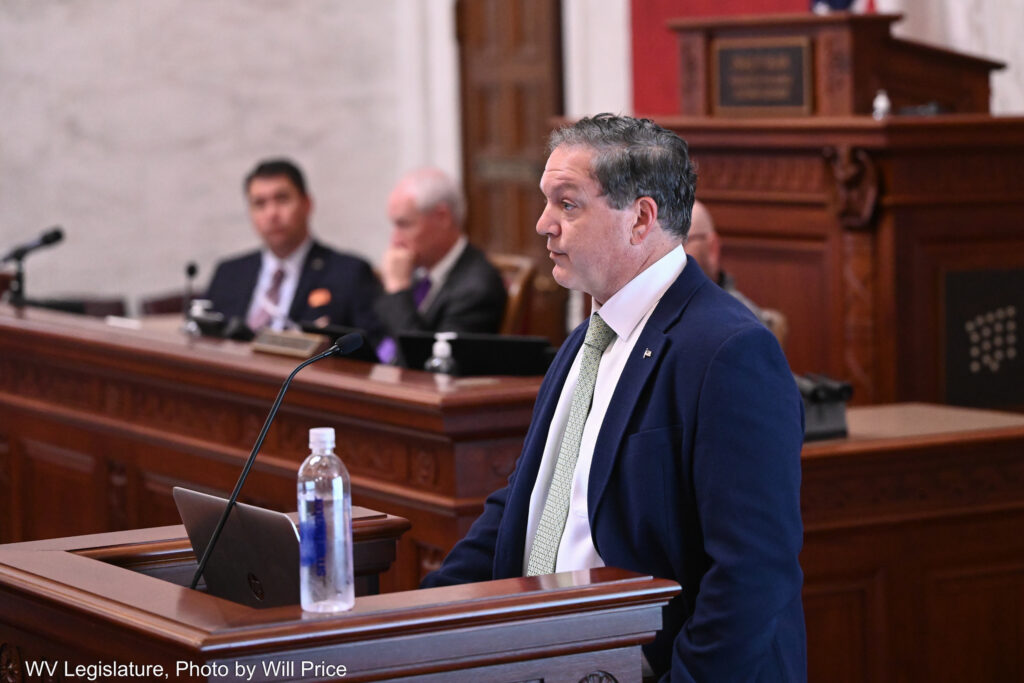
West Virginia Public Employees Insurance Agency Director Brian Cunningham speaks to members of the Joint Standing Committee on Insurance and PEIA during legislative interim meetings Monday, Nov. 11, 2024, in Charleston, W.Va. (Will Price | West Virginia Legislative Photography)
As the West Virginia Public Employees Insurance Agency continues to hear from members about proposed premium increases for next year, Director Brian Cunningham on Monday presented lawmakers with ideas for stabilizing the agency going forward.
Cunningham provided an update to the Joint Standing Committee on Insurance and PEIA.
Under a plan that would equal about $113 million for the 2026 fiscal year, PEIA has proposed increasing its premiums by 14% for state employees and by 16% for local government employees. The fiscal year begins July 1, 2025.
PEIA retirees’ premiums would go up by 12%. Both state and county employees would see an increase of 40% in their out-of-pocket maximum as well as increase in co-pays. A monthly spousal surcharge for state employees would more than double, from $147 to $350.
PEIA’s finance board started a series of public hearings across the state about the proposed changes last week. The public hearings continue Tuesday in Martinsburg and conclude in Charleston on Nov. 21. The complete list of public hearings is available on the PEIA website. The finance board is expected to vote on the proposal during its meeting Dec. 5.
To help stabilize the agency’s finances going forward, Cunningham suggested lawmakers consider clarifying legislation that requires that providers be reimbursed 110% of what Medicare would reimburse them.
Cunningham said he believes that Senate Bill 268, which went into effect in July 2023, was intended to target reimbursement for inpatient hospitals, but it’s been interpreted to include all health care providers.
“What we’d like to consider at PEIA is not paying 110% to all health care providers,” Cunningham said. “In fact, what we see at PEIA is that we are overpaying compared to national averages for some services.”
Cunningham suggested lawmakers also clarify the rules around a “gold card provider” program, that allows doctors to prescribe without prior authorization from PEIA. GLP-1 drugs require a diagnosis of type 2 diabetes in order for PEIA to pay for them, but without the prior authorization, there’s no way for the agency to enforce that rule, he said.
Cunningham said lawmakers may also want to consider lifting a moratorium on additional non-state agencies joining PEIA.
The cost of GLP-1 drugs, which treat obesity and diabetes, have been a driver of the increased costs for PEIA, Cunningham said. The drugs accounted for $52.5 million, or 20% of PEIA’s overall net drug spend in state fiscal year 2024, Cunningham said.
PEIA recently suspended a pilot weight loss program with the state’s three bariatric centers of excellence at West Virginia University, Charleston Area Medical Center and Cabell Huntington Hospital. Under the program, 1,000 PEIA participants had access to GLP-1s like Wegovy and Zepbound for weight loss. The program cost $7.5 million in fiscal year 2024, he said.
Cunningham said there may be ways that PEIA can save money by using GP1s for improving health outcomes. The agency has attempted to work with drug manufacturers to provide the weight loss management pilot program, but when PEIA tried to up the requirements for getting the drugs for weight loss — raising the body mass index required to have access to it — the companies took away rebates for the drugs, he said.
“We simply can’t afford to provide GLP-1s for weight management that are not rebated,” Cunningham said.
If PEIA were to cover GPL-1 drugs across the board for weight management, 70,000 members would be eligible under a requirement of a 27 body mass index with comorbidities, or a body mass index of 30 without comorbidities. If a quarter of those eligible under those criteria used the drugs, that would mean 17,500 members and $260 million in gross prescription drug costs, he said.
Even if the cost were half of that because of rebates and people going on and off the drugs, “We’re still looking at $130 million, which is half of the net drug spend at PEIA right now,” he said.
YOU MAKE OUR WORK POSSIBLE.

